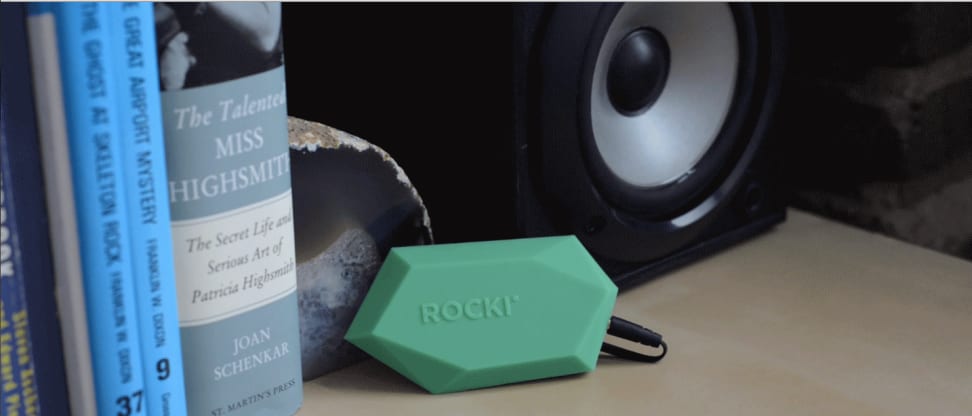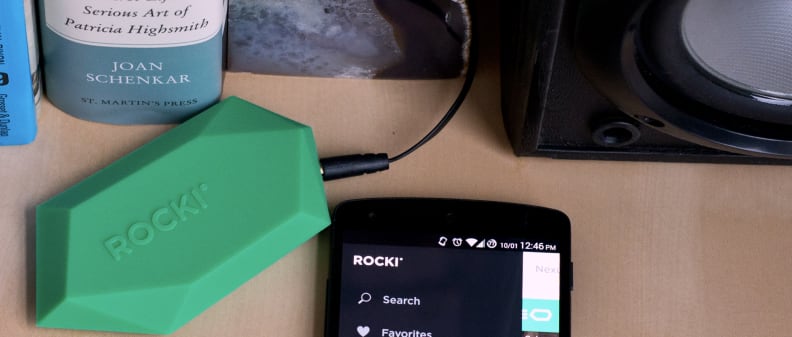Hands-on Review: Kickstarter Success Rocki Makes Wireless Home Audio Affordable
The age of smart homes has arrived, and it means great things for your music.
 Credit:
Credit:
Products are chosen independently by our editors. Purchases made through our links may earn us a commission.
My name is Chris Thomas, and I'm a tinkerer. I'm the guy who slaps NFC tags all over the house, uses hacked-together computer parts to connect the devices in my home, and desperately wants tomorrow to get here yesterday. But after managing to DIY my own home of the future, sometimes I just want a simple solution that looks good, is easy to use, and doesn't require hours of troubleshooting.
Some time ago, I bought my first Raspberry Pi, a miniature programmable computer that I used to stream music and video from my home server throughout the house. It worked, but I doubt a lot of people want to spend as much time or money doing what I did. Being a music junkie, I'm always on the lookout for a better solution.
Rocki may not be exactly that solution yet, but it's got a pretty good shot.
What is Rocki?
>sudo assimilate "home stereo"
Rocki is a successfully funded Kickstarter project designed to wirelessly connect your stereo to your smartphone. In simpler terms Rocki is a small, colorful WiFi receiver that hooks into any standard 3.5mm jack. We took a look at it earlier this year, but it wasn't until recently I got to spend some time with three units where it matters: in my own home.

Plant a Rocki in every room you want to use it in, and control the sound system with your smartphone.
The Rocki itself is tiny, smaller than a deck of cards. But for something that will wind up hidden behind your stereo equipment, it's very stylish. It's angular, fits in your hand, and comes in such punny colors as "Paint it BLACK," and "Clockwork ORANGE." It's very obvious that a lot of effort went into designing every detail of the device, as it makes the most of limited hardware; the cables are flat and tangle-free, there are almost no moving parts to break, and the rubber sleeve means it won't slide off your entertainment center anytime soon. It can even fit through a mail slot upon delivery.
All things considered, the device itself doesn't seem all that exciting—it's a fun little package made up mostly of standard parts that have existed for quite some time—hardly the stuff of revolutions. But what makes Rocki so interesting isn't the hardware, but the software the connects the entire experience.
Why Should I Care?
Resistance isn't futile—it's voltage over current.
Sonos is currently the market leader in connected home audio, and anyone who's ever used their system knows exactly why: With their setup, you can control your entire home's audio from your phone or iPod Touch with no issues. Want to listen to Jimmy Buffett in the pool while your dog needs NPR to fall asleep? Easy peasy with the Sonos app.

There's a battery nestled inside to power the Rocki if you can't get to an outlet.
However, Sonos equipment, like most high-end audio equipment, gets very pricey, very quickly. You can try building a setup for yourself—it's enormously expensive. Oh, and that HiFi system you've had for years? Yeah, cram that in the closet, unless you want to spend $349 for the part to connect it to your system. No matter what, you're looking at spending several hundred—if not thousand—dollars to control all the audio devices in your home.
Rocki fills the same role as Sonos' Connect module, letting you send audio to your existing stereo equipment over your wireless network—but at $50 per unit it does so for 1/7th the price. The cheapest connected speaker that Sonos sells is $200 brand-new. For that price you could buy four Rockis and have one in the bedroom, living room, kitchen, or anywhere you've got a speaker systems that'll take a 3.5mm input. That's quite a savings if all you want to do is stream music to the equipment you've already got.
The problem is that, as a startup, Rocki's got some obstacles to overcome if it wants to take on established competitors. Questions of production, quality control, and even app development are legitimate concerns. This becomes obvious as soon as you hook up Rocki; some streaming services like Google Play Music don't have an official API yet, so Rocki has no way to talk to those services.
What's it Like?
At $50 a pop, you get what you pay for...for now.
I'm not going to mince words: The setup for Rocki is a bit of a pain in the neck. Because Rocki operates via WiFi (and not directly to your phone via Bluetooth) it has to connect to your router. If you've ever owned a router, ever, you probably understand that routers don't play nice with anything. If your router isn't set up just so the Rocki doesn't work right.
All in all it took me about 10 (relatively frustrating) minutes to get three Rockis functioning. Your mileage may vary, though, for better or worse. Once everything was set up and I had the app open, it took a little while to figure out where everything was in order to control it. This is probably the main source of my gripes: the app is designed to be minimalistic to the point where it's not clear where some of the major functions are—and a large number of Google Play reviews back that up.

There are lots of colors to choose from, but black and green seem to be the favorites.
Leaving aside technical difficulties, the Rocki is actually a cool concept once you've got it running. Like Sonos's Connect amp, you can hide them behind your existing stereo systems and stream music right from your phone anywhere in your home. You can even stream different audio files to different Rocki at the same time, or even use multiple phones to control a single Rocki at a party without having to change anything.
But here too, the device shows its immaturity and shortcomings. Though there was a lot of bluster about streaming services signing on to support this device, so far only SoundCloud, Rhapsody and Last.fm have default options in the app. Google Play Music, Amazon's new Prime streaming, Pandora, and even Spotify are all missing—and that's a massive letdown for content subscribers. Checking Rocki's forums reveals that there are some workarounds you can use to remedy this, but many include rooting your device and/or using the aforementioned Raspberry Pi as a streaming server... which means you're back to square one.
For those of you keeping score at home, this means you'll likely only be streaming music that you have stored locally on your phone. Though Sonos has support for most streaming services, Rocki does not—and for many, that makes the plucky little device a non-starter—for now.
Conclusion
Savior of the iTunes hoarder
At the end of the day, Rocki provides enough value to justify its $50 price tag if you're looking for a convenient way to stream locally stored music at your house. Aside from the convenience of the app, the main draw is the use of WiFi instead of Bluetooth dongles. WiFi not only lets you operate the Rocki from anywhere in the house, it also lets you stream much higher quality audio.

The whole setup is so small it can fit in your pocket.
But right now, Rocki isn't quite living up to its full potential. Luckily, its problems are generally fixable: Its app can always get an update, Google could share their Play Music API with Rocki, and Spotify and Pandora are surely on Rocki's shortlist when it comes to future support. None of those are exactly mountains to climb. The Rocki has all the muscle in place to be a disruptive force when it comes to the music streaming market—it just needs a little more work.
If you've got a good library of music on your computer or phone, this is a great way to stream content to your speakers wirelessly—without damage to audio quality. It's not quite a Sonos system, but then again, it's 1/7th the price. Even though some audiophiles will more than happily shell out whatever is required to get Sonos, the Rocki is a credible alternative that is much simpler than the hacky, DIY route. It may not hit its full potential right out of the box, but Rocki is certainly off to a good start.
